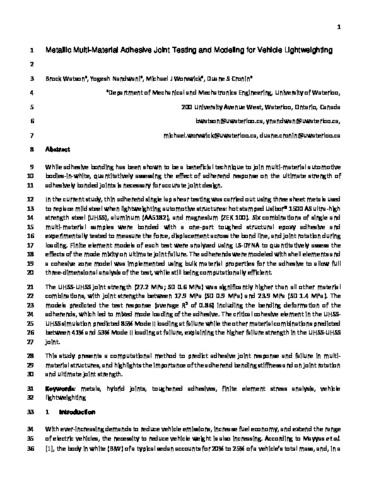| dc.contributor.author | Watson, Brock | |
| dc.contributor.author | Nandwani, Yogesh | |
| dc.contributor.author | Worswick, Michael J. | |
| dc.contributor.author | Cronin, Duane | |
| dc.date.accessioned | 2023-05-01 19:22:08 (GMT) | |
| dc.date.available | 2023-05-01 19:22:08 (GMT) | |
| dc.date.issued | 2019-12 | |
| dc.identifier.uri | https://doi.org/10.1016/j.ijadhadh.2019.102421 | |
| dc.identifier.uri | http://hdl.handle.net/10012/19382 | |
| dc.description | The final publication is available at Elsevier via https://doi.org/10.1016/j.ijadhadh.2019.102421. © 2019. This manuscript version is made available under the CC-BY-NC-ND 4.0 license http://creativecommons.org/licenses/by-nc-nd/4.0/ | en |
| dc.description.abstract | While adhesive bonding has been shown to be a beneficial technique to join multi-material automotive bodies-in-white, quantitatively assessing the effect of adherend response on the ultimate strength of adhesively bonded joints is necessary for accurate joint design.
In the current study, thin adherend single lap shear testing was carried out using three sheet metals used to replace mild steel when lightweighting automotive structures: hot stamped Usibor® 1500 AS ultra-high strength steel (UHSS), aluminum (AA5182), and magnesium (ZEK 100). Six combinations of single and multi-material samples were bonded with a one-part toughed structural epoxy adhesive and experimentally tested to measure the force, displacement across the bond line, and joint rotation during loading. Finite element models of each test were analyzed using LS-DYNA to quantitatively assess the effects of the mode mixity on ultimate joint failure. The adherends were modeled with shell elements and a cohesive zone model was implemented using bulk material properties for the adhesive to allow full three-dimensional analysis of the test, while still being computationally efficient.
The UHSS-UHSS joint strength (27.2 MPa; SD 0.6 MPa) was significantly higher than all other material combinations, with joint strengths between 17.9 MPa (SD 0.9 MPa) and 23.9 MPa (SD 1.4 MPa). The models predicted the test response (average R2 of 0.86) including the bending deformation of the adherends, which led to mixed mode loading of the adhesive. The critical cohesive element in the UHSS-UHSS simulation predicted 85% Mode II loading at failure while the other material combinations predicted between 41% and 53% Mode II loading at failure, explaining the higher failure strength in the UHSS-UHSS joint. This study presents a computational method to predict adhesive joint response and failure in multi-material structures, and highlights the importance of the adherend bending stiffness and on joint rotation and ultimate joint strength. | en |
| dc.language.iso | en | en |
| dc.publisher | Elsevier | en |
| dc.relation.ispartofseries | International Journal of Adhesion and Adhesives;102421 | |
| dc.subject | metals | en |
| dc.subject | hybrid joints | en |
| dc.subject | toughened adhesives | en |
| dc.subject | finite element stress analysis | en |
| dc.subject | vehicle lightweighting | en |
| dc.title | Metallic Multi-Material Adhesive Joint Testing and Modeling for Vehicle Lightweighting | en |
| dc.type | Article | en |
| dcterms.bibliographicCitation | Watson, B., Nandwani, Y., Worswick, M. J., & Cronin, D. S. (2019). Metallic multi-material adhesive joint testing and modeling for Vehicle Lightweighting. International Journal of Adhesion and Adhesives, 95, 102421. https://doi.org/10.1016/j.ijadhadh.2019.102421 | en |
| uws.contributor.affiliation1 | Faculty of Engineering | en |
| uws.contributor.affiliation2 | Mechanical and Mechatronics Engineering | en |
| uws.typeOfResource | Text | en |
| uws.peerReviewStatus | Reviewed | en |
| uws.scholarLevel | Graduate | en |

